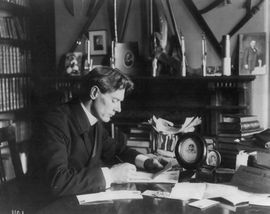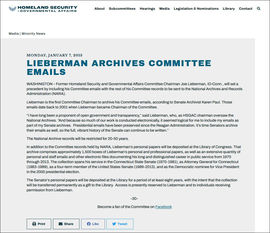The legacy of generations of U.S. senators—contained in letters, memos, photographs, handwritten notes—rests in climate-controlled stacks, preserved by acid-free folders for the enduring curiosity of researchers. But in recent decades, the nature of archives has changed. Where once the record lived in ink and envelope, it now resides in networks, clouds, and code.
The transformation of congressional archives from paper to born-digital formats reflects more than a shift in technology. It marks a turning point in how our national memory is preserved and how these unique records are accessed by future generations. From the meticulously penned letters of Senator Albert Beveridge to the terabyte of digital data in Senator John McCain’s recent donation, the evolution of archival practice reveals both challenge and opportunity.

The Tangibility of Tradition: The Albert J. Beveridge Papers
Republican Albert J. Beveridge represented Indiana in the U.S. Senate from 1899 to 1911. Throughout his career he championed several progressive causes, including consumer food safety and a 1906 proposal to ban child labor, which eventually led to the passage of the Keating-Owen Child Labor Act of 1916. The bulk of his papers, housed at the Library of Congress in Washington, D.C., span more than 40 years of American thought and politics. These are records you can touch: crisp correspondence written in iron gall ink, typed speeches on onion-skin paper, and newspaper clippings folded with care. Comprising roughly 100,000 items, this collection reflects the conventions of its age—arranged into defined series and stored in more than 400 carefully arranged boxes on climate-controlled shelves.1
The challenges of preserving such a collection are tactile and environmental. Paper degrades. Ink fades. Heat and humidity hasten decay. Archivists face constant vigilance—controlling light exposure, monitoring temperature, and conserving fragile pages. Accessibility, too, presents challenges. With no digital surrogates and limited item-level description, researchers rely upon finding aids and box lists, rather than modern keyword searches and remote computer access.
Yet there is a poetry to these physical documents. The weight of history is felt quite literally in one’s hands. Senator Beveridge’s papers offer an intimate, almost sensory connection to the past—one that remains indispensable, even as archival strategies have evolved. The decision to place his papers in the Library of Congress ensured that accessibility to this connection would outlive the senator’s lifetime. Researchers who utilize Beveridge’s records can find drafts of speeches and articles, general correspondence, as well as records tracing the evolution of state and national politics.2

Bridging Eras: The Daniel Patrick Moynihan Papers
Senators’ commitment to provide public access to their congressional records carried into the digital age. Senator Daniel Patrick Moynihan, a Democrat, represented New York from 1977 to 2001, a period during which he emerged as one of the Senate’s leading voices on social welfare policy, intelligence oversight, and government transparency. His career, like his papers, spanned textual and digital worlds. Housed in the Library of Congress, his 1.3 million-item collection includes not only the expected letters, memos, and photographs, but also 275 digital files—early artifacts of a changing technological landscape.3
These born-digital components, modest in number but rich in complexity, introduced new demands on archival work. Floppy disks and CD-ROMs offered neither durability nor standardization. Rapidly evolving file formats threatened obsolescence almost as quickly as they emerged. Some emails arrived as printed pages, others as saved text files, and archivists were left to piece together the whole, tracing context, connection, and chronology across media types.
Senator Moynihan’s archive is a study in contrast—a bridge between worlds. As technology evolved, so too did the demands on archival practice. For archivists, this collection offered an early test case in managing hybrid records, foreshadowing the complexity that would soon become the norm. For researchers, it remains a vivid portrait of an era when word processors began to replace typewriters and the archive started to slip beyond the page. That portrait exists today because Senator Moynihan understood the importance of preserving and making available all of his records.

Into the Digital Fold: The Joseph Lieberman Papers
The political career of Joseph Lieberman of Connecticut spanned 40 years, from his service in the state senate (1970–1980) to his terms as state attorney general (1983, 1986–1988), to his tenure as U.S. senator (1989–2013). By the time he retired in 2013, email was ubiquitous, documents lived on shared drives, and offices were moving quickly toward a paperless environment. His donation of his political collection to the Library of Congress included 1,500 boxes of physical material and an extensive volume of digital content—emails, early word processing files, staff memos, legislative drafts, digital photographs, and other electronic records—from his personal Senate office. These records document Lieberman’s legislative efforts to protect the environment, safeguard the nation through the creation of the Department of Homeland Security, secure access to healthcare, and advance civil rights, among other accomplishments.4
During Senator Lieberman’s tenure, his staff did what few had done before—they prepared their digital records for eventual deposit in an archive. Aware of the long-term importance of these records, his staff established policies to save documents, organize file folders, and capture day-to-day interactions and decision-making. By choosing to include these digital records in his collection, particularly internal communications and staff correspondence (then an uncommon practice), Senator Lieberman, a Democrat turned Independent, demonstrated a commitment to government accountability. “I have long been a proponent of open government and transparency,” Lieberman explained. “Because so much of our work is conducted electronically, it seemed logical for me to include my emails as part of my Senate archives.”5
Archivists, in turn, faced a daunting task: processing terabytes of files in a jumble of formats, many tied to proprietary platforms, some stored in legacy systems long since abandoned. Maintaining such a collection demands more than hardware. It requires fluency in digital archival standards and systems capable of safeguarding the integrity of digital records. Context must be preserved—not just the content of an email, but who sent it, who received it, and what thread it answered. Without this, digital records become hollow shells, stripped of meaning.
Digital collections raise complex questions for archivists—how to balance openness with privacy, manage large quantities of sensitive correspondence, and navigate issues of ownership, redaction, and access in a networked environment. As processing of his collection continues in preparation for public access, Senator Lieberman’s papers serve as an early test case for how digital legacies can be responsibly managed in an era of rapid technological change. His collection pushed the boundaries of traditional archival practice.

Archives in the Cloud: The John S. McCain Papers
While the Lieberman Papers reflect a growing awareness of the importance of digital stewardship, the Senator John S. McCain Papers at Arizona State University (ASU) offer a detailed case study of the challenges and solutions that come with managing a born-digital archive that encompasses millions of files.
Republican John S. McCain III represented Arizona in the House of Representatives from 1983 to 1987 and in the U.S. Senate from 1987 until his death in 2018. McCain’s legislative initiatives included campaign finance reform, veterans’ affairs, national security and defense, immigration, and international human rights. ASU first acquired Senator McCain's House papers in the late 1990s. The McCain family significantly expanded the collection by donating the senator's extensive Senate and campaign records to ASU in 2019. This donation included more than 1,900 linear feet of paper and over 1 terabyte of digital files—totaling more than 3.9 million individual items and thousands of unique file types.6
Managing a modern congressional collection of significant size and complexity requires thoughtful investment in space, technology, and personnel. Successful stewardship depends on assembling a team with expertise in both traditional archival practices and digital preservation strategies. Institutions must often acquire specialized equipment, secure storage solutions, and robust computing infrastructure to support access, processing, and long-term care. Archivists may apply methods such as selective sampling and digital forensics to assess, stabilize, and prepare the collection for future use while maintaining the authenticity and integrity of the records.
The McCain Papers and the plan for their eventual availability to researchers and the public demonstrate how modern congressional archives are shaped not just by what is donated but also by how they are managed. Senator McCain’s records reflect more than a senator’s career; they show how a legacy of public service now depends on the effective preservation and accessibility of digital information. Preserving born-digital records at this scale requires institutional readiness, including adequate infrastructure, technical skills, strategic planning, and meaningful engagement with the public through outreach, collaboration, and transparency. For repositories facing similar challenges, the McCain collection provides a model for preserving and providing access to the complex digital record of a senator’s public service.
The Archival Pivot: Challenges and Continuities Toward Legacy and Stewardship
These four collections reflect a clear evolution from the linear logic of paper files to the dynamic sprawl of digital ecosystems. Each stage has demanded its own kind of care. For paper, that care means controlled humidity, acid-free folders, and meticulous arrangement. For hybrid collections, it means recovering obsolete formats, aligning analog and digital content, and building new description practices. For digital archives, it means maintaining file integrity, navigating proprietary systems, preserving metadata context, and ensuring long-term access in the face of software drift and platform dependency. In the early 21st century, a press release might begin as a Word doc, cycle through multiple drafts, be emailed to staff, published on a website, and posted on social media, all in a matter of hours. Capturing that full chain of activity is essential to understanding the record in its original context.
Archival practices have adapted to this shifting technological landscape, developing new practices to ensure that the past can be examined with rigor and interpreted with context. This evolution is not merely technical—it is political, historical, and deeply human. When a senator chooses to preserve their legacy in a repository committed to long-term access, it is an act of foresight and public service. It offers future generations insight into the values, debates, and decisions that shaped a given era. But this insight is only possible if the records survive, and survival now depends on action.
A Final Reflection
As historian Arthur Schlesinger Jr. observed in a 1974 letter to Senate Majority Leader Mike Mansfield and Minority Leader Hugh Scott, “If we are going to persuade the nation that Congress plays a vital role in the formation of national policy, Congress will have to cooperate by providing evidence for its contributions.” Congressional archives safeguard historical memory—not just the words themselves, but the provenance that makes them trustworthy. Anthropologist Michel-Rolph Trouillot argues in Silencing the Past that archives are shaped during the “moment of fact assembly,” when decisions about what to preserve, how to describe it, and what to exclude can influence the contours of collective memory. While individual memories may fade, congressional archival collections anchor our shared understanding of the past by documenting governmental processes. Whether held in acid-free folders or stored on secure servers, these records include the raw material of history, ready to be shaped and assembled by future generations.7
Notes
1. Albert J. Beveridge papers, 1789–1943, Manuscript Division, Library of Congress, online finding aid accessed June 10, 2025, https://hdl.loc.gov/loc.mss/eadmss.ms011132.
3. Daniel P. Moynihan papers, 1765–2003, Manuscript Division, Library of Congress, online finding aid accessed June 10, 2025, https://hdl.loc.gov/loc.mss/eadmss.ms008066.
4. Ana Radelat, “Burnishing his legacy, Lieberman to leave his official papers to the Library of Congress,” CT Mirror, August 28, 2013, accessed May 20, 2025, https://perma.cc/A7NE-PKTL.
5. “Lieberman Archives Committee Emails,” Senate Committee on Homeland Security and Governmental Affairs, January 7, 2013, accessed June 5, 2025, https://perma.cc/B7MM-ML4N.
6. “From the archives: A glimpse into the future library and museum,” Arizona State University McCain Library and Museum, accessed June 5, 2025, https://perma.cc/S34N-CYR8.